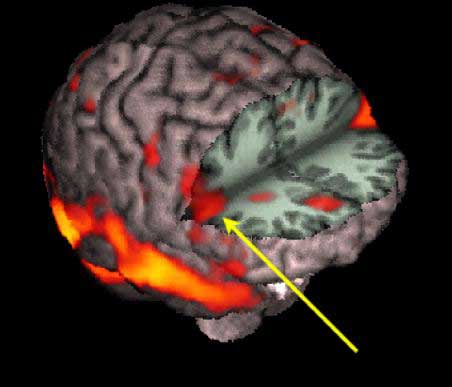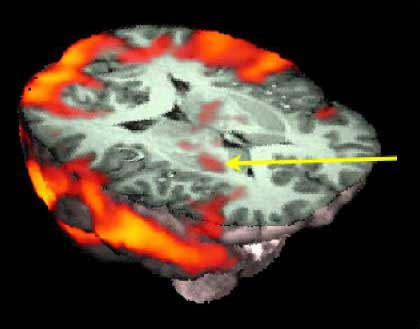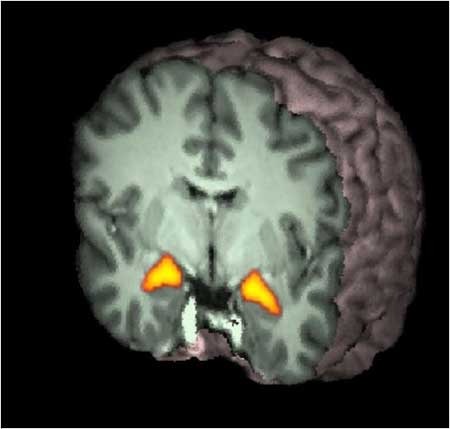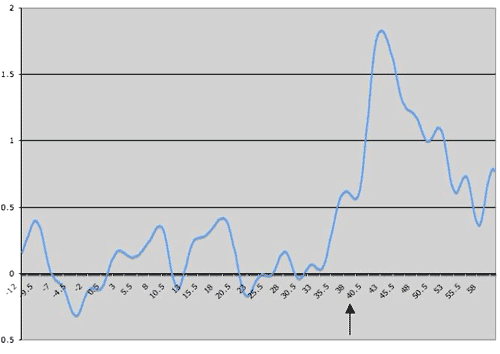
(-UPDATE- the Superbowl ads can be viewed on googlevideo at the following: link)
PART I - 2.6.06
The Story of an Instant-Science Experiment
Science has generally a very slow pace. It typically takes months — if not years — to complete an experiment. Today, at the UCLA Brain Mapping Center, my associates Jonas Kaplan, and Eric Mooshagian performed under my supervision an experiment that lasted only few hours. True, we are still analyzing a good 60% of the data, but by tomorrow the 'instant-science experiment' will be basically completed. The idea was to do brain imaging of Super Bowl ads, and to do it the very same night the ads were shown for the first time. With the help of FKF Applied Research and its experience in advertising, we managed to upload digitized ads and run the brain imaging experiment in five healthy volunteers. The participating subjects were interviewed after the experiment, to test whether the brain data collected in the scanner matched what the subjects thought they liked or disliked. This is just a preliminary report on the first analyses, I will be posting a final report later today or tomorrow.
Who won the Super Bowl ads competition? If a good indicator of a successful ad is activity in brain areas concerned with reward and empathy, two winners seem to be the 'I am going to Disney' ad and the Bud 'office' ad. In contrast, two big floppers seem to be the Bud 'secret fridge' ad and the Aleve ad. What is quite surprising, is the strong disconnect that can be seen between what people say and what their brain activity seem to suggest. In some cases, people singled out ads that elicited very little brain responses in emotional, reward-related, and empathy-related areas.
Among the ads that seem relatively successful, I want to single out the Michelob ad. Above is a picture showing the brain activation associated with the ad. What is interesting is the strong response — indicated by the arrow — in 'mirror neuron' areas, premotor areas active when you make an action and when you see somebody else making the same action. The activity in these areas may represent some form of empathic response. Or, given that these areas are also premotor areas for mouth movements, it may represent the simulated action of drinking a beer elicited in viewers by the ad. Whatever it is, it seems a good brain response to the ad.
PART II - 2.7.06
Complete results of the instant-science brain imaging experiment on Super Bowl ads
We have now completed our analyses on the fMRI data from five healthy volunteers that were studied last night at the UCLA Brain Mapping Center while they were watching Super Bowl ads. We tested a total of 24 ads, 21 Super Bowl ads and three ‘test ads’ that were previously shown. Our results show that the overwhelming winner among the Super Bowl ads is the Disney – NFL ‘I am going to Disney’ ad. The Disney ad elicited strong responses in orbito-frontal cortex and ventral striatum, two brain regions associated with processing of rewards. Also, the Disney ad induced robust responses in mirror neuron areas, indicating identification and empathy. Further, the circuit for cognitive control, encompassing anterior cingulate cortex and dorsolateral prefrontal cortex, was highly active while watching the Disney ad. We consider all these features positive markers of brain responses to the ad. In second place, the Sierra Mist ad, activated the same brain regions but less so than the Disney ad.
Considering the hype surrounding the ads, I would say several ads performed poorly when judged on the basis of the brain activity induced in key areas for social behavior. However, the three biggest flops seem to be the Burger King ad, the FedEx ad, and the GoDaddy ad. Three quite interesting features that come out of this instant-study are the following: first, people – when interviewed - tend to say what they are expected to say, but their brain seems to say the opposite. For instance, female subjects may give verbally very low ‘grades’ to ads using actresses in sexy roles, but their mirror neuron areas seem to fire up quite a bit, suggesting some form of identification and empathy. Second, in some fMRI runs we presented the same ad twice, just to test for habituation. We saw strong habituation effects, such that the second time around the commercial induces much weaker responses. Third - and this is probably interesting to neuroscientists – among brain regions associated with complex social behavior, we observed a mix of activation and de-activation. Only mirror neuron areas demonstrated quite a systematic activation while watching the ads, a feature that one generally sees only in perceptual areas, such as auditory and visual areas. This suggests that mirroring is a fairly automatic processing. However, in mirror neuron areas we did observe different degrees of activation.
Finally, the highlights of the day. This is the brain activity of one of our subjects recorded while the subject was watching the Disney ad. Both mirror neuron areas and ventral striatum – indicated by the yellow arrows – are engaged by the ad.
|
Mirror neuron activity in the right posterior inferior frontal gyrus – indicating identification and empathy - while watching the Disney/NFL ad. |
|
Ventral striatum activity – indicating reward processing - while watching the Disney/NFL ad. |
Another interesting finding is the following one. Remember the end of the FedEx ad, when the caveman is crushed by the dinosaur? We looked at the activity in the amygdala, a tiny brain structure (see picture below) critical for emotional processing in general, especially responding to threat and fearful stimuli.
|
|
There is a big jump in amygdala activity when the dinosaur crushes the caveman, as shown below. The scene looks funny and has been described as funny by lots of people, but your amygdala still perceives it as threatening, another example of disconnect between verbal reports on ads and brain activity while viewing the ads.
|
Activity in the amygdala while watching the FedEx ad. The ad lasts 45 seconds and the caveman crushing is shown toward the end (approximately where the black arrow is). There is a large increase in neural activity in the amygdala when the dinosaur crushes the caveman. |






